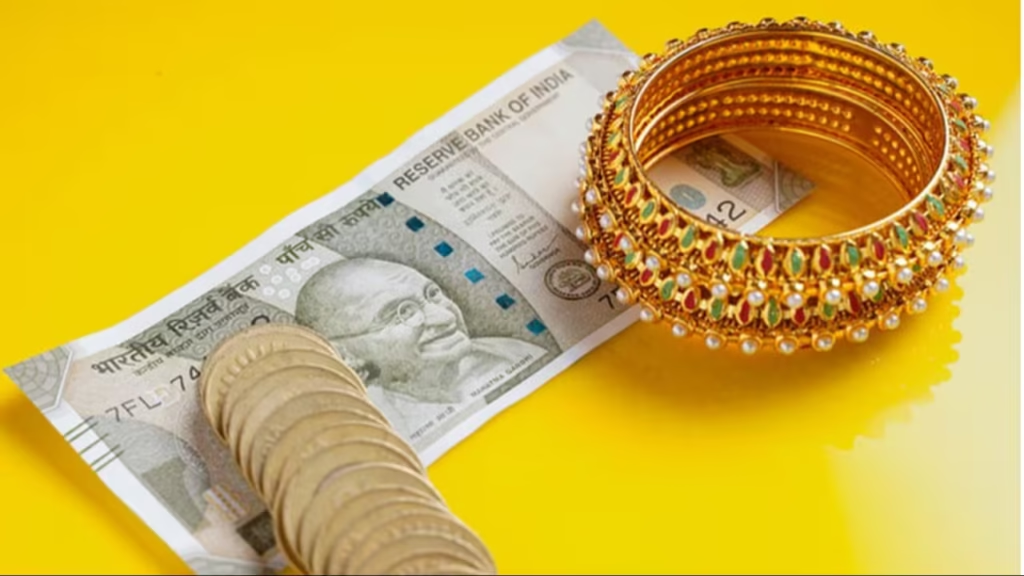Small Finance Banks: The gold loan market in India is witnessing a remarkable boom, with small finance banks (SFBs) and scheduled commercial banks ramping up their gold-backed lending portfolios to leverage growing customer demand. In a year marked by sluggish overall credit growth across most lending categories, gold loans have emerged as the standout performer in the Indian banking sector. The surge in gold prices, coupled with relaxed RBI regulations on loan-to-value (LTV) ratios, has made this segment one of the most lucrative opportunities for lenders seeking secured, high-yield growth.
As credit growth in unsecured segments such as personal and microfinance loans faces headwinds, small finance banks are strategically shifting their focus toward secured lending models like gold loans. The combination of high liquidity, minimal default risk, and the ability to quickly mobilize capital has made gold loans an attractive asset class. In fact, RBI data reveals that loans against jewellery surged 117% in August 2025, compared with just 40% a year earlier — a clear indicator of how this market is expanding.
This strong performance reflects both consumer and institutional interest. Borrowers are increasingly leveraging gold to access liquidity for consumption, business expansion, and income generation, while lenders are keen to diversify portfolios, enhance asset quality, and tap into the gold loan segment’s growing profitability.
Small Finance Banks Eye Gold Loan Expansion
Equitas Small Finance Bank: Building a Secured Portfolio
Equitas Small Finance Bank is among the key players scaling up operations in the gold loan segment. According to Murali Vaidyanathan, Senior President and Country Head – Branch Banking at Equitas SFB, the bank aims to focus on customers in three key segments — consumption, business expansion, and income generation.
Equitas is prioritizing secured lending to balance out risks from unsecured products and to improve its overall loan book quality. The bank is expected to expand branch operations and deploy more employees on the ground to service this rapidly growing segment.
Ujjivan Small Finance Bank: Strengthening Ground Presence
Ujjivan Small Finance Bank is also capitalizing on the strong gold loan demand. “Rising gold prices have increased our focus on growing the gold loan business. Currently, we operate through a network of approximately 350 branches offering gold loans. We are actively working to expand this footprint and enhance presence to capitalize on emerging opportunities in the market,” said Vibhas Chandra, Head – Micro Banking and Gold Loans at Ujjivan SFB.
By strengthening its branch network and increasing frontline manpower, Ujjivan aims to enhance reach, particularly in semi-urban and rural areas where gold remains a preferred form of collateral.
Gold Loan Market Sees Record Growth
The gold loan market has demonstrated phenomenal growth this year. As per the Reserve Bank of India’s data, loans against jewellery stood at ₹62.13 lakh crore as of August 22, marking a 117% growth year-on-year. This growth is being driven by multiple factors:
- Record-high gold prices both domestically and globally
- Easier regulatory norms from the RBI
- Increased credit appetite from small business owners and rural consumers
Globally, international gold prices touched an all-time high of $4,194 per ounce, while domestic prices rose above ₹1,30,338 per 10 grams, according to Bloomberg data. The price rally, triggered by strong global demand and expectations of interest rate cuts by the US Federal Reserve, has significantly increased the collateral value of gold holdings in India.
Why Gold Loans Are Becoming a Strategic Bet
Small finance banks are facing margin pressures and portfolio stress from their exposure to the microfinance sector, where default rates have been higher post-pandemic. In this context, gold loans provide a stable, secured alternative that helps balance risk.
Unlike unsecured personal loans, gold-backed lending carries lower default risk, as the collateral can be easily liquidated in the event of non-payment. Moreover, the short tenure and high yield of gold loans make them a profitable segment for banks with limited balance sheet capacity.
Gold loans also serve a diverse borrower base — from small traders and farmers to salaried individuals — who need quick liquidity for working capital, seasonal expenses, or emergencies.
Read about: Deerfield Finance Committee Hesitant on Clima
Managing Portfolio Risks Amid Gold Price Volatility
While the gold loan business is booming, lenders remain cautious due to the volatility in gold prices. Sudden declines in market value can expose banks to mark-to-market losses. To mitigate these risks, SFBs are tightening credit underwriting norms.
This conservative approach ensures that even if gold prices correct sharply, lenders remain adequately secured against defaults.

RBI’s Revised LTV Norms Boost Gold Loan Growth
In June 2025, the Reserve Bank of India (RBI) introduced revised guidelines that made gold loans more accessible for borrowers and more attractive for lenders. The updated Loan-to-Value (LTV) ratios are as follows:
- Loans below ₹2.5 lakh: LTV increased from 75% to 85%
- Loans between ₹2.5 lakh and ₹5 lakh: LTV increased to 80%
- Loans above ₹5 lakh: LTV remains capped at 75%
Additionally, the RBI removed credit appraisal and end-use monitoring requirements for smaller-ticket loans, significantly simplifying the process for customers and lenders alike. These regulatory relaxations are expected to accelerate disbursements and attract more small borrowers into the formal banking system.
The Road Ahead: Gold Loans as a Growth Engine
The gold loan segment is emerging as a key growth driver for small finance banks amid an otherwise sluggish credit environment. As lenders diversify portfolios away from microfinance and unsecured consumer lending, gold loans are expected to play a central role in ensuring asset quality stability and liquidity strength.
The dual advantage of high collateral security and growing customer demand positions gold loans as one of the most resilient lending products in the Indian banking ecosystem. With RBI’s supportive stance and record-high gold prices, the sector is set to see sustained momentum through 2026.
Conclusion
The gold loan market has evolved from a niche segment into a mainstream growth engine for India’s small finance banks. The combination of rising gold valuations, regulatory support, and customer preference for secured credit is fueling rapid expansion across the sector.
Small finance banks like Equitas and Ujjivan are leading this transformation by scaling operations, expanding branch networks, and enhancing portfolio management practices. These efforts not only strengthen their asset base but also help mitigate risk amid market volatility.
As global and domestic gold prices continue their upward trajectory, the appeal of gold loans — both for borrowers seeking liquidity and banks pursuing profitability — is only set to grow stronger. The sector’s outlook remains bullish, provided lenders maintain prudent underwriting and risk controls.
In the coming years, gold-backed lending is likely to become a cornerstone of financial inclusion, providing both stability to the banking ecosystem and access to credit for millions of households across India.
Also read: Chickenpox Cases Surge Rapidly in Kollam, Health Alert Declared in District
Frequently Asked Questions
1. Why are small finance banks focusing on gold loans now?
Small finance banks are turning to gold loans to diversify away from unsecured segments like microfinance, which carry higher default risks. Gold loans offer secured, high-yield returns and help improve capital efficiency and liquidity management.
2. How much have gold loans grown in India recently?
According to the Reserve Bank of India, gold loans against jewellery grew by 117% in August 2025, compared to 40% a year ago, with total outstanding loans reaching ₹62.13 lakh crore.
3. What are the new RBI guidelines for gold loans?
The RBI revised Loan-to-Value (LTV) ratios in June 2025 — increasing limits to 85% for loans below ₹2.5 lakh and 80% for loans up to ₹5 lakh. It also eased credit appraisal and end-use monitoring requirements for smaller loans, making disbursement faster and simpler.
4. How do rising gold prices affect the gold loan business?
Higher gold prices increase the value of pledged collateral, enabling borrowers to access larger loan amounts. However, they also expose banks to price correction risks, prompting lenders to adopt conservative LTV policies and tighter credit controls.
5. What is the outlook for gold loans in 2026?
With record-high gold prices, RBI policy support, and strong demand from both retail and business borrowers, the gold loan segment is projected to grow at a double-digit pace through 2026. It is expected to remain a key pillar of secured lending for both small finance banks and mainstream commercial lenders.

1 thought on “Small Finance Banks to Scale Up Gold Loan Business Amid Soaring Demand and Rising Gold Prices”